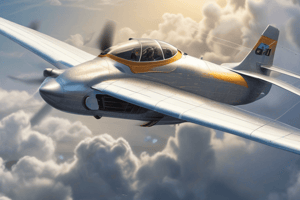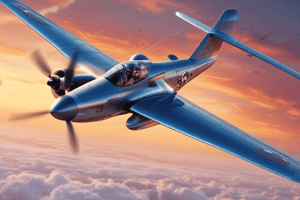Podcast
Questions and Answers
What is the term for a heavier-than-air craft that requires relative movement between the air and its lifting surfaces?
What is the term for a heavier-than-air craft that requires relative movement between the air and its lifting surfaces?
- Aeroplane
- Aerostat
- Helicopter
- Aerodyne (correct)
What does the word 'plane' refer to in the context of an aeroplane?
What does the word 'plane' refer to in the context of an aeroplane?
- The horizontal stabiliser
- The vertical stabiliser
- The complete aircraft
- The main wings and tail-plane (correct)
What is the term for a lighter-than-air craft?
What is the term for a lighter-than-air craft?
- Aeroplane
- Helicopter
- Aerodyne
- Aerostat (correct)
What is the term for a rotary-wing craft?
What is the term for a rotary-wing craft?
What is the focus of this book on Principles of Flight?
What is the focus of this book on Principles of Flight?
What is the meaning of the Greek word 'heliko' in the context of helicopters?
What is the meaning of the Greek word 'heliko' in the context of helicopters?
What percentage of the atmosphere is composed of Oxygen?
What percentage of the atmosphere is composed of Oxygen?
What is the approximate total depth of the atmosphere?
What is the approximate total depth of the atmosphere?
What is the primary function of the atmosphere in relation to aeroplanes?
What is the primary function of the atmosphere in relation to aeroplanes?
What is the approximate percentage of the atmosphere that lies in the lower 50 000 feet?
What is the approximate percentage of the atmosphere that lies in the lower 50 000 feet?
What is the primary component of the atmosphere?
What is the primary component of the atmosphere?
What is the approximate altitude that jet airliners regularly fly at?
What is the approximate altitude that jet airliners regularly fly at?
What is the term used to describe the amount of water vapour in an air mass?
What is the term used to describe the amount of water vapour in an air mass?
What is the maximum percentage of water vapour in atmospheric air by volume?
What is the maximum percentage of water vapour in atmospheric air by volume?
What happens to the air when it reaches its saturation point?
What happens to the air when it reaches its saturation point?
What is the term for the temperature at which water vapour condenses out to water?
What is the term for the temperature at which water vapour condenses out to water?
Why can you see your breath on a cold day?
Why can you see your breath on a cold day?
What happens to the dew point when there is more water vapour in the air?
What happens to the dew point when there is more water vapour in the air?
What occurs when air reaches its saturation point?
What occurs when air reaches its saturation point?
What is the result when the air reaches its saturation point?
What is the result when the air reaches its saturation point?
What is the difference between fog and mist?
What is the difference between fog and mist?
Why does breathing onto a cold glass surface cause the glass to mist up?
Why does breathing onto a cold glass surface cause the glass to mist up?
What is relative humidity an expression of?
What is relative humidity an expression of?
What happens when the air temperature falls to the dew point?
What happens when the air temperature falls to the dew point?
What is the characteristic of a mixture of air and water vapour with high water vapour content?
What is the characteristic of a mixture of air and water vapour with high water vapour content?
What is the relationship between water vapour and dry air at equal pressure?
What is the relationship between water vapour and dry air at equal pressure?
What is the main reason why air molecules are held in contact with the Earth's surface?
What is the main reason why air molecules are held in contact with the Earth's surface?
What is the relationship between air pressure and air density?
What is the relationship between air pressure and air density?
What happens to the volume of air when it is heated at constant pressure?
What happens to the volume of air when it is heated at constant pressure?
What is the unit of measurement for air density?
What is the unit of measurement for air density?
What is the effect of the weight of air above on the air near the surface?
What is the effect of the weight of air above on the air near the surface?
What is the main factor that determines the air density?
What is the main factor that determines the air density?
What is the result of the gravitational force acting between the Earth and air molecules?
What is the result of the gravitational force acting between the Earth and air molecules?
What is the analogy used to describe the variation of pressure and density with altitude?
What is the analogy used to describe the variation of pressure and density with altitude?
What happens to air density when temperature increases?
What happens to air density when temperature increases?
What is the effect of decreasing pressure on air density?
What is the effect of decreasing pressure on air density?
Why do pilots need to be careful when operating from airfields that are 'hot and high'?
Why do pilots need to be careful when operating from airfields that are 'hot and high'?
What is the standard unit of pressure?
What is the standard unit of pressure?
What is the direction of the force exerted by atmospheric pressure?
What is the direction of the force exerted by atmospheric pressure?
What is the reason for the atmosphere exerting pressure on objects?
What is the reason for the atmosphere exerting pressure on objects?
What happens to the lift generated by the wings when air density is low?
What happens to the lift generated by the wings when air density is low?
What is the effect of decreasing air density on the power output of the engine?
What is the effect of decreasing air density on the power output of the engine?
What is the result of low air density on take-off runs?
What is the result of low air density on take-off runs?
What happens to atmospheric pressure with increasing altitude?
What happens to atmospheric pressure with increasing altitude?
What is the primary source of heat for the atmospheric air?
What is the primary source of heat for the atmospheric air?
What is the name of the lowest layer of the atmosphere?
What is the name of the lowest layer of the atmosphere?
At what altitude does the temperature begin to rise again?
At what altitude does the temperature begin to rise again?
What percentage of the total mass of the atmosphere is in the Troposphere?
What percentage of the total mass of the atmosphere is in the Troposphere?
What is the term for the boundary between the Troposphere and the Stratosphere?
What is the term for the boundary between the Troposphere and the Stratosphere?
At what altitude is the temperature around -56.5°C (-69°F) in the Troposphere?
At what altitude is the temperature around -56.5°C (-69°F) in the Troposphere?
What is the altitude of the Troposphere over the Equator?
What is the altitude of the Troposphere over the Equator?
Why does the temperature decrease with increasing altitude in the Troposphere?
Why does the temperature decrease with increasing altitude in the Troposphere?
What is a measure of air's resistance to flow?
What is a measure of air's resistance to flow?
What is true about the viscosity of air?
What is true about the viscosity of air?
What is affected by the viscosity of air in flight?
What is affected by the viscosity of air in flight?
What is a characteristic of fluids with high viscosity?
What is a characteristic of fluids with high viscosity?
What is true about air compared to treacle and tar?
What is true about air compared to treacle and tar?
What is the purpose of understanding ISA deviations in flight?
What is the purpose of understanding ISA deviations in flight?
What is the standard sea level pressure in ISA conditions?
What is the standard sea level pressure in ISA conditions?
What is the term for the altitude read from an altimeter with the subscale setting of 1013.2 millibars?
What is the term for the altitude read from an altimeter with the subscale setting of 1013.2 millibars?
Why is it important to consider ISA deviations when reading aircraft performance data?
Why is it important to consider ISA deviations when reading aircraft performance data?
Where can more information on ISA deviations be found?
Where can more information on ISA deviations be found?
What is the primary purpose of the ICAO Standard Atmosphere (ISA)?
What is the primary purpose of the ICAO Standard Atmosphere (ISA)?
What is the air pressure at Mean Sea Level in the ICAO Standard Atmosphere (ISA)?
What is the air pressure at Mean Sea Level in the ICAO Standard Atmosphere (ISA)?
What is the temperature at Mean Sea Level in the ICAO Standard Atmosphere (ISA)?
What is the temperature at Mean Sea Level in the ICAO Standard Atmosphere (ISA)?
How does the temperature change with altitude in the ICAO Standard Atmosphere (ISA)?
How does the temperature change with altitude in the ICAO Standard Atmosphere (ISA)?
Why is it important to remember that actual atmospheric values can differ from ISA values?
Why is it important to remember that actual atmospheric values can differ from ISA values?
What is the purpose of the ICAO Standard Atmosphere (ISA) in relation to aircraft instruments?
What is the purpose of the ICAO Standard Atmosphere (ISA) in relation to aircraft instruments?
What is the significance of the ICAO Standard Atmosphere (ISA) in the field of aviation?
What is the significance of the ICAO Standard Atmosphere (ISA) in the field of aviation?
What does the ICAO Standard Atmosphere (ISA) illustrate?
What does the ICAO Standard Atmosphere (ISA) illustrate?
What is the standard unit of temperature measurement in the aviation world outside the United States?
What is the standard unit of temperature measurement in the aviation world outside the United States?
At what temperature does water freeze in degrees Celsius?
At what temperature does water freeze in degrees Celsius?
What is the formula to convert from Fahrenheit to Celsius?
What is the formula to convert from Fahrenheit to Celsius?
What is the ratio of a Fahrenheit degree to a Celsius degree?
What is the ratio of a Fahrenheit degree to a Celsius degree?
At what temperature does water boil in degrees Fahrenheit?
At what temperature does water boil in degrees Fahrenheit?
What is the formula to convert from Celsius to Fahrenheit?
What is the formula to convert from Celsius to Fahrenheit?
Flashcards are hidden until you start studying
Study Notes
Definition of Aircraft
- Aircraft can only fly when immersed in air.
- Lighter-than-air craft are called aerostats (e.g. hot-air balloons).
- Heavier-than-air craft that require relative movement between air and their lifting surfaces are called aerodynes.
Types of Aerodynes
- Fixed-wing craft are called generically aeroplanes.
- Aeroplanes include mainplanes (wings), tail-plane (horizontal stabiliser), and fin (vertical stabiliser).
- Rotary-wing craft are collectively known as helicopters.
Etymology of Helicopter
- The word "helicopter" comes from the Greek "pterón" (meaning wing) and "heliko" (from "helix", meaning spiral).
- Inspired by Leonardo da Vinci's 15th-century design for a vertical take-off flying machine with a rotating spiral wing.
Scope of the Book
- This book focuses on the principles of flight for aeroplanes only.
- The terms "aeroplane" and "aircraft" will be used interchangeably throughout the book.
The Composition of the Atmosphere
- The atmosphere is a gaseous mixture that surrounds the Earth, similar to a giant ocean of air.
- The lower 10,000 feet of the atmosphere is where most private-pilot licence-holders operate their light aircraft.
- Jet airliners regularly fly at altitudes up to about 40,000 feet.
- The total depth of the atmosphere is approximately 500 miles (800 km).
- About 90% of the mass of air lies in the lower 50,000 feet (9 miles or 15 km) of the atmosphere.
Principal Gases in the Atmosphere
- Nitrogen makes up 78% of the atmosphere.
- Oxygen makes up 21% of the atmosphere.
- The remaining 1% consists mainly of Argon and Carbon Dioxide, with traces of:
- Carbon Monoxide
- Helium
- Methane
- Hydrogen
- Ozone
Water Vapour and Humidity
- Atmospheric air contains a small amount of water vapour, which varies in quantity.
- Humidity is the measure of the amount of water vapour in an air mass.
- Meteorologists measure humidity in terms of mass of water vapour per unit volume of air (e.g., 5 gm/m³) or mass of water vapour per unit mass of air (e.g., 3 gm/kg).
- Water vapour in the air is usually invisible, but its influence on weather is significant.
- The air can hold more water vapour as temperature increases, and less as temperature decreases.
Saturation Point and Dew Point
- When air can no longer hold any more water vapour as gas, it reaches its saturation point.
- The temperature of air at its saturation point is called the dew point.
- The more water vapour in the air, the higher the dew point will be.
- When the dew point is close to the actual air temperature, the danger of condensation and mist or fog increases.
Cloud Formation and Condensation
- When unsaturated air rises and cools, it eventually reaches its saturation point, forming cloud.
- Mist and fog are low-level clouds that form when the air reaches its saturation point.
- If visibility is less than 1000 m, it is termed fog, and if 1000 m or more, it is termed mist.
Relative Humidity
- Relative humidity is the ratio of actual water vapour in the air to the amount the air can hold at a given temperature.
- When the air temperature falls to the dew point, relative humidity becomes 100%, and the air becomes saturated.
Properties of Water Vapour
- Water vapour is lighter than dry air at equal pressure and temperature.
- A mixture of air and water vapour is less dense if the water vapour content is high than if it is low.
Formation of the Atmosphere
- The atmosphere was formed over 4 billion years ago when gases were released from the Earth during its formation.
- The Earth's gravity prevented the gases from escaping into space, causing them to spread out and cover the entire surface.
Air Pressure and Air Density
- Air pressure and air density are greatest near the Earth's surface and decrease with increasing altitude.
- The weight of the air above compresses the air near the surface, leading to higher pressure and density.
- Air density refers to the number of air molecules contained within a given volume of air and is measured in kilograms per cubic meter.
- Air density is directly proportional to pressure and inversely proportional to temperature.
Effects of Air Density on Aircraft Performance
- Air density affects lift, service ceiling, and the relationship between true and indicated airspeed.
- Low air density reduces lift, engine power output, and requires longer take-off runs.
Pressure
- Pressure is a description of the way in which a force is spread over a contact area.
- Pressure is defined as "force per unit area".
- Atmospheric pressure or static pressure is the pressure exerted by the atmosphere on objects immersed in it when neither the air nor the object is in motion.
- Standard units of pressure include Newtons per square meter, pounds per square inch, bars, millibars, Pascals, and hectopascals.
Properties of Air
- Air possesses mass, and the force of gravity acting on that mass gives air weight.
- The pressure and density of air decrease with altitude due to the weight of the air.
- Variations in atmospheric pressure and density, along with humidity, affect aircraft performance and flight instruments.
Temperature of the Atmosphere
- The temperature of atmospheric air decreases with increasing altitude.
- The air is not heated directly by the sun, but rather by the Earth's surface through conduction, convection, and long-wave radiation.
The Troposphere
- The lowest layer of atmospheric air is the Troposphere, which is heated through its proximity to the Earth's surface.
- The Troposphere is where temperature and pressure changes cause the mixing of air, resulting in weather.
- Almost all of the Earth's weather occurs in the Troposphere.
- The Troposphere rises from the Earth's surface to about 50,000 feet over the Equator, 25,000 feet over the Poles, and about 36,000 feet at mid-latitudes.
- The Troposphere contains approximately 75% of the total mass of the atmosphere and all of the water vapour.
The Tropopause
- The boundary between the Troposphere and the Stratosphere is called the Tropopause.
- At the Tropopause, the temperature is around -56.5°C (-69°F) and remains constant to an altitude of about 18 miles (35 km).
Temperature Variation with Altitude
- The temperature begins to rise again at altitudes greater than 18 miles (35 km).
- The temperature variation with altitude ends at around 95,000 feet.
Physical Properties of the Atmosphere
- Air has mass, which is an essential fact in understanding the Principles of Flight.
- The atmosphere's physical properties, including pressure, density, temperature, and relative humidity, change under certain circumstances.
Viscosity of Air
- Viscosity measures the air's resistance to flow due to internal friction between air molecules moving relative to each other.
- Air has a low viscosity, making it a "thin" fluid, similar to water.
- In contrast, fluids like treacle and tar have high viscosity, making them "thick" fluids.
- Despite being low, air's measurable viscosity has significant consequences for an aircraft in flight.
ICAO Standard Atmosphere (ISA)
- The ICAO Standard Atmosphere (ISA) is a set of standard values for air pressure, density, temperature, and humidity defined by the International Civil Aviation Organisation (ICAO) in 1964.
Purpose of ISA
- The ISA serves as an international standard reference for measuring aircraft performance and calibrating instruments.
- It provides a common set of atmospheric conditions for aerodynamicists, aircraft manufacturers, and engineers to work with.
Characteristics of ISA
- The ISA shows a standard variation of pressure, temperature, density, and viscosity with altitude.
- The Mean Sea Level air pressure in the ISA is 1013.2 millibars (1013.2 hectopascals) or 29.92 inches of Mercury.
- The ISA temperature at Mean Sea Level is 15°C.
- Temperature decreases with altitude at approximately 2°C for every 1,000 ft.
Importance of ISA
- ISA values are used as a reference for calibrating flight instruments, such as the altimeter and air speed indicator, and for manufacturers' figures for aircraft performance.
- It is essential to understand the effect of the atmosphere's deviation from ISA conditions on instrument readings and aircraft performance.
ISA and Flight Levels
- The ISA sea level pressure of 1013.2 millibars is also the altimeter subscale setting, which a pilot selects when reading their altitude in terms of Flight Level.
- Flight Levels are also known as Pressure Altitudes.
Measurement of Temperature
- The standard unit of temperature measurement in the aviation world, outside the United States, is degrees Celsius (formerly Centigrade).
- Until the 1960s, the Fahrenheit scale was the primary scale of temperature measurement for non-scientific purposes in most English-speaking countries.
Fahrenheit Scale
- In the Fahrenheit scale, water freezes at 32ºF and boils at 212ºF.
- There are 180º between the boiling points of water in the Fahrenheit scale.
Celsius Scale
- In the Celsius scale, water freezes at 0ºC and boils at 100ºC.
- There are 100º between the boiling points of water in the Celsius scale.
Conversion between Scales
- One Fahrenheit degree is only 5/9 the value of a Celsius degree.
- The formulae for converting between the two scales are:
- ºC = (ºF - 32) × 5/9 (Fahrenheit to Celsius)
- ºF = (ºC × 9/5) + 32 (Celsius to Fahrenheit)
Studying That Suits You
Use AI to generate personalized quizzes and flashcards to suit your learning preferences.




